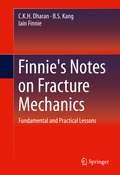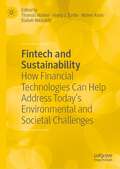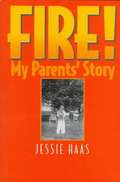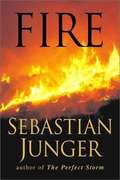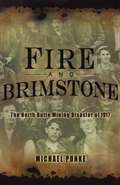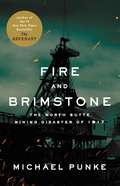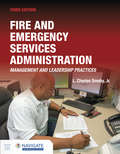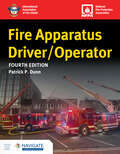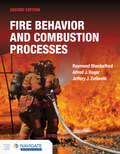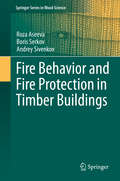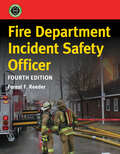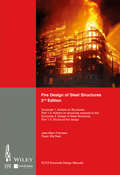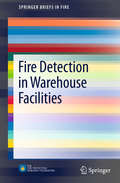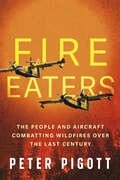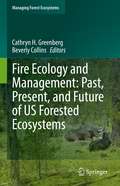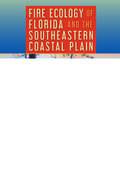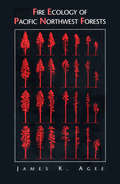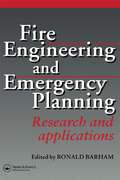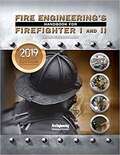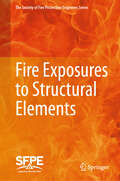- Table View
- List View
Finnie's Notes on Fracture Mechanics
by C. K. H. Dharan B. S. Kang Iain FinnieThis textbook consists primarily of notes by Iain Finnie who taught a popular course on fracture mechanics at the University of California at Berkeley. It presents a comprehensive and detailed exposition of fracture, the fundamentals of fracture mechanics and procedures for the safe design of engineering components made from metal alloys, brittle materials like glasses and ceramics, and composites. Interesting and practical problems are listed at the end of most chapters to give the student practice in applying the theory. A solutions manual is provided to the instructor. The text presents a unified perspective of fracture with a strong fundamental foundation and practical applications. In addition to its role as a text, this reference would be invaluable for the practicing engineer who is involved in the design and evaluation of components that are fracture critical. This book also: Presents details of derivations of the basic equations of fracture mechanics and the historical context of the development of fracture theory and methodology Treats linear and nonlinear fracture mechanics methodologies beginning with a review of the basic equations of solid mechanics followed by solutions useful in fracture prediction Illustrates the basis of linear elastic fracture mechanics (LEFM), practical applications of LEFM in the design of fracture-tolerant structural components Offers interesting, practical, classroom proven problems at the end of most chapters Includes instructor's solutions manual
Fintech and Sustainability: How Financial Technologies Can Help Address Today’s Environmental and Societal Challenges
by Thomas Walker Harry Turtle Maher Kooli Elaheh NikbakhtFintech can improve sustainability, influence policies, and require new regulations. Climate change, water pollution, and non-renewable resources management can all be addressed with fintech innovations. Despite the advantages offered by fintech, opponents warn of potential negative consequences. The application of fintech in sustainability is a double-edged sword requiring further investigation. This book provides an overview of fintech applications and considers their impact on the future of sustainable finance. It explores how financial technologies can enhance the sustainability of investment and corporate decisions and contribute to the fulfillment of the Sustainable Development Goals (SDGs). By considering practitioner and academic views, it examines whether and how fintech can improve sustainable practices, potential threats with possible solutions, and policies and regulations designed to improve sustainability benefits.
Fintech with Artificial Intelligence, Big Data, and Blockchain (Blockchain Technologies)
by Paul Moon Sub Choi Seth H. HuangThis book introduces readers to recent advancements in financial technologies. The contents cover some of the state-of-the-art fields in financial technology, practice, and research associated with artificial intelligence, big data, and blockchain—all of which are transforming the nature of how products and services are designed and delivered, making less adaptable institutions fast become obsolete. The book provides the fundamental framework, research insights, and empirical evidence in the efficacy of these new technologies, employing practical and academic approaches to help professionals and academics reach innovative solutions and grow competitive strengths.
Fire!: My Parents' Story
by Jessie Haas"Don't be afraid. The house is afire." It's spring in Vermont, in 1948. A fire has started in an isolated farmhouse, and eight-year-old Patty is the first to discover it. Help is slow to come.<P> Patty and her family must save themselves, and save their animals. Jessie Haas's family history is as rich and powerful as any work of fiction, and she tells it with suspense and sensitivity. "Fire!" is the story of her parents' struggle and survival, and of life in Vermont fifty years ago.
Fire: Fundamentals and Control
by Walter M. HaesslerThis book is devoted to the complex nature of fire, the intricasies of the combustion process, the influence of chemical and physical properties of fuels, and the proper means of fire extinguishment. It lists sequentially the various factors in the combustion process.
Fire
by Sebastian JungerSebastian Junger details his first-hand experiences as he describes fire fighting. As a seasoned journalist he travels the world and brings the reader face to face with many crises.
Fire and Brimstone
by Michael PunkeThere is a sign that appears to point persistently to a terrible explosion underground. -HOROSCOPE PRINTED IN THE ANACONDA STANDARD, JUNE 5, 1917
Fire and Brimstone: The North Butte Mining Disaster of 1917
by Michael PunkeThe author of the #1 New York Times bestseller, The Revenant--basis for the award-winning motion picture starring Leonardo DiCaprio--tells the remarkable story of the worst hard-rock mining disaster in American history. The worst hard-rock mining disaster in American history began a half hour before midnight on June 8, 1917, when fire broke out in the North Butte Mining Company's Granite Mountain shaft. Sparked more than two thousand feet below ground, the fire spewed flames, smoke, and poisonous gas through a labyrinth of underground tunnels. Within an hour, more than four hundred men would be locked in a battle to survive. Within three days, one hundred and sixty-four of them would be dead.Fire and Brimstone recounts the remarkable stories of both the men below ground and their families above, focusing on two groups of miners who made the incredible decision to entomb themselves to escape the gas. While the disaster is compelling in its own right, Fire and Brimstone also tells a far broader story striking in its contemporary relevance. Butte, Montana, on the eve of the North Butte disaster, was a volatile jumble of antiwar protest, an abusive corporate master, seething labor unrest, divisive ethnic tension, and radicalism both left and right. It was a powder keg lacking only a spark, and the mine fire would ignite strikes, murder, ethnic and political witch hunts, occupation by federal troops, and ultimately a battle over presidential power.
Fire and Emergency Services Administration: Management and Leadership Practices
by L. Charles Smeby Jr.Fire and Emergency Services Administration: Management and Leadership Practices, Third Edition, provides aspiring and current chief officers who administer, manage, or lead fire, emergency medical services (EMS), rescue, and/or emergency management organizations with the knowledge to make policy decisions and the skills needed to lead their organizations through progressive change.
Fire Apparatus Driver/Operator with Navigate Advantage Access
by Patrick P. DunnBrought to you in partnership with the NFPA and the IAFC, Fire Apparatus Driver/Operator, Fourth Edition is a complete print and digital training solution that addresses preventive maintenance, pump operations, safe driving techniques, tiller and aerial apparatus operations, and mobile water supply considerations.
Fire Behavior and Combustion Processes with Advantage Access
by Raymond ShackelfordFire Behavior and Combustion Processes, Second Edition provides a straightforward, comprehensive resource for students in fire science degree programs, an up-to-date refresher for active firefighters, and an engaging experience for all learners.
Fire Behavior and Fire Protection in Timber Buildings
by Roza Aseeva Boris Serkov Andrey SivenkovThis volume describes fire behavior and fire protection of timbers in outdoors and indoors application mainly in construction industry. The Authors' novel approach considers the relationship between various species and age of timbers and its fire behavior at different thermal and fire loads. Quantitative data of ignition speed and flame propagation as well as generation of heat, smoke and toxic products are discussed. Analysis of fire resistance of various types of building materials based on timber of different species as well as the novel data on the effect of natural and accelerated aging of timbers on its fire behavior are discussed. The main practical methods of fire protection of new and ancient timber buildings and structures to increase its fire resistance are considered. The book should be useful for a wide range of readers: chemists, physicists, material scientists, architects, engineers, constructors and restorers.
Fire Department Incident Safety Officer
by null Forest F ReederFire Department Incident Safety Officer, Fourth Edition with Navigate Advantage Access is a print and digital solution that prepares aspiring and current incident safety officers (ISOs) to meet and exceed the specific job requirements outlined in NFPA 1550, which includes Chapter 5, Incident Safety Officer (NFPA 1521).
Fire Design of Steel Structures: EC1: Actions on structures; Part 1-2: Actions on structure exposed to fire; EC3: Design of steel structures; Part 1-2: Structural fire design
by Jean-Marc Franssen Paulo Vila RealThis book explains and illustrates the rules that are given in the Eurocodes for designing steel structures subjected to fire. After the first introductory chapter, Chapter 2 explains how to calculate the mechanical actions (loads) in the fire situation based on the information given in EN 1990 and EN 1991. Chapter 3 is dedicated to the models which represent the thermal actions created by the fire. Chapter 4 describes the procedures to be used to calculate the temperature of the steelwork from the temperature of the compartment and Chapter 5 shows how the information given in EN 1993-1-2 is used to determine the load bearing capacity of the steel structure. Chapter 6 presents the essential features that characterize the advanced calculation models, for thermal and mechanical response. The methods used to evaluate the fire resistance of bolted and welded connections are described in Chapter 7. Chapter 8 describes a computer program called `Elefir-EN? which is based on the simple calculation model given in the Eurocode and allows designers to quickly and accurately calculate the performance of steel components in the fire situation. Chapter 9 looks at the issues that a designer may be faced with when assessing the fire resistance of a complete building. This is done via a case study and addresses most of the concepts presented in the previous chapters. For this second edition the content has been revised and extended. The book contains some new sections, e.g. a comparison between the simple and the advanced calculation, as well as additional examples.
Fire Detection in Warehouse Facilities
by Joshua Dinaburg Daniel T. GottukAutomatic sprinklers systems are the primary fire protection system in warehouse and storage facilities. The effectiveness of this strategy has come into question due to the challenges presented by modern warehouse facilities, including increased storage heights and areas, automated storage retrieval systems (ASRS), limitations on water supplies, and changes in firefighting strategies. The application of fire detection devices used to provide early warning and notification of incipient warehouse fire events is being considered as a component of modern warehouse fire protection. Fire Detection in Warehouse Facilities provides technical information to aid in the development of guidelines and standards for the use of fire detection technologies for modern warehouse fire protection. The authors share their thorough literature review, analyze characteristic fire hazards for modern warehouse facilities, and identify information gaps in the field. The book concludes with recommendations for the development of guidelines and standards for the use of detection technologies in warehouse fire protection design, including a research plan for implementation. This book is intended for practitioners seeking an understanding of the issues surrounding warehouse design and fire protection. The book will also prove valuable for fire hazard researchers and those involved with fire department response, applicable detection systems, and fire growth suppression.
Fire Eaters: The People and Aircraft Combatting Wildfires Over the Last Century
by Peter PigottThe riveting history of how aircraft have transformed the fighting of wildfires. Throughout history, when threatened by wildfires our only defense was to pray for rain and run — until aircraft changed the way we fight fires. Beginning with the Canadian “H-Boats” in 1924, aircraft have become indispensable in detecting and extinguishing wildfires. Fire Eaters tells the incredible stories of the Ontario Provincial Air Service, the first government aerial fire suppression organization in history; one of its pilots, Carl Crossley, who invented the water scoop-up and drop-off system; and the Canadair CL-215, the first purpose-built water bomber. Today, helicopters with “Bambi Buckets” and snorkels can dump water while hovering directly over the flames, and Air Tractors and Dash 8-400AT air tankers not only perform a crucial role in saving communities but also protect our ecosystem. Satellites — unmanned aircraft able to fly for sixteen hours, even overnight when manned aircraft do not — and artificial intelligence already play a decisive role in fire management. But it is the men and women of the aerial fire service who have really changed the way we fight fire around the world. Their bravery and dedication mean that response times are fast, fires can be contained sooner, and people have the chance to save rather than lose everything.
Fire Ecology and Management: Past, Present, and Future of US Forested Ecosystems (Managing Forest Ecosystems #39)
by Cathryn H. Greenberg Beverly CollinsThis edited volume presents original scientific research and knowledge synthesis covering the past, present, and potential future fire ecology of major US forest types, with implications for forest management in a changing climate. The editors and authors highlight broad patterns among ecoregions and forest types, as well as detailed information for individual ecoregions, for fire frequencies and severities, fire effects on tree mortality and regeneration, and levels of fire-dependency by plant and animal communities. The foreword addresses emerging ecological and fire management challenges for forests, in relation to sustainable development goals as highlighted in recent government reports. An introductory chapter highlights patterns of variation in frequencies, severities, scales, and spatial patterns of fire across ecoregions and among forested ecosystems across the US in relation to climate, fuels, topography and soils, ignition sources (lightning or anthropogenic), and vegetation. Separate chapters by respected experts delve into the fire ecology of major forest types within US ecoregions, with a focus on the level of plant and animal fire-dependency, and the role of fire in maintaining forest composition and structure. The regional chapters also include discussion of historic natural (lightning-ignited) and anthropogenic (Native American; settlers) fire regimes, current fire regimes as influenced by recent decades of fire suppression and land use history, and fire management in relation to ecosystem integrity and restoration, wildfire threat, and climate change. The summary chapter combines the major points of each chapter, in a synthesis of US-wide fire ecology and forest management into the future.This book provides current, organized, readily accessible information for the conservation community, land managers, scientists, students and educators, and others interested in how fire behavior and effects on structure and composition differ among ecoregions and forest types, and what that means for forest management today and in the future.
Fire Ecology of Florida and the Southeastern Coastal Plain
by Reed F. NossAn overview of the importance of fire to ecosystems in the Southeast, with guidance on how to best conduct controlled burns in the regionA biodiversity hotspot, Florida is home to many ecosystems and species that evolved in the presence of frequent fire. In this book, Reed Noss discusses the essential role of fire in generating biodiversity and offers best practices for using fire to keep the region's ecosystems healthy and resilient. Reviewing several lines of evidence, Noss shows that fire has been important to the southeastern Coastal Plain for tens of millions of years. He explains how the region's natural fire regimes are connected to its climate, high rate of lightning strikes, physical chemistry, and vegetation. But urbanization and active fire suppression have reduced the frequency and extent of fires. Noss suggests the practice of controlled burning can and should be improved to protect fire-dependent species and natural communities from decline and extinction. Noss argues that fire managers should attempt to simulate natural fire regimes when conducting controlled burns. Based on what the species of the Southeast likely experienced during their evolutionary histories, he makes recommendations about pyrodiversity, how often and in what seasons to burn, the optimal heterogeneity of burns, mechanical treatments such as cutting and roller-chopping, and the proper use of fuel breaks. In doing so, Noss is the first to apply the new discipline of evolutionary fire ecology to a specific region. This book is a fascinating history of fire ecology in Florida, an enlightening look at why fire matters to the region, and a necessary resource for conservationists and fire managers in the state and elsewhere.
Fire Ecology of Pacific Northwest Forests
by James K AgeeThe structure of most virgin forests in the western United States reflects a past disturbance history that includes forest fire. James K. Agee, an expert in the emergent field of fire ecology, analyzes the ecological role of fire in the creation and maintenance of natural western forests, focusing primarily on forest stand development patterns. His discussion of the natural fire environment and the environmental effects of fire is applicable to a wide range of temperate forests.
Fire Engineering and Emergency Planning: Research and applications
by R. BarhamProtection against fire and prevention of explosion is vital in a modern industrial economy. This published proceedings of the First European Conference on Fire Engineering and Emergency Planning provides an authoritative base of materials covering the latest research, applications and hypotheses as a cumulative reference work and a platform for exchanges of ideas within the academic fire community.
Fire Engineering of Structures
by M.Y.H. Bangash Y.F. Al-Obaid F. N. BangashThis book provides a general introduction to the three-dimensional analysis and design of buildings for resistance to the effects of fire and is intended for a general readership, especially those with an interest in the design and construction of buildings under severe loads. A major aspect of design for fire resistance involves the building elements or components. The emphasis is placed on structure, which has a primary role in preventing serious damage or structural collapse. Much of the material in this book examines building structures. The designed examples are based on three-dimensional finite elements.
Fire Engineering's Handbook for Firefighter 1 and 2
by Glenn CorbettFire Engineering’s Handbook for Firefighter I & II is written to 2019 NFPA Standards 1001. From fire service history to basic fire attack and building construction to firefighter safety, Fire Engineering’s 2019 update is the standard instruction handbook for firefighters. <p><p>It contains lessons learned from more than 40 experienced subject-matter experts who share their insight and knowledge. Edited by Glenn Corbett, Fire Engineering magazine’s technical editor, this 2019 update gives readers practical, real-world, time-tested knowledge and skills.
Fire Evacuation and Exit Design in Heritage Cultural Centres (SpringerBriefs in Architectural Design and Technology)
by John Gales René Champagne Georgette Harun Hannah Carton Michael KinseyThis book highlights human behaviour and architectural considerations for prescriptive code requirements for emergency exits in heritage cultural centers. Closed circuit television camera (CCTV) footage from a Canadian heritage cultural centre was analyzed from three separate unannounced evacuations, where recommendations based on the first two evacuations were implemented for the third. This study aims to (1) develop a baseline for the behaviour and actions of people during the pre-movement and movement stages of emergency egress and evacuation situations and (2) collect behavioural and movement data to aid the fire safety community with the decision process for egress and evacuation strategies and (3) interrogate and highlight architectural barriers in heritage structures with respect to emergency evacuation. The discussion of findings includes occupant behaviour, architectural implications and evacuation modelling and considers the often-conflicting intersection between architectural conservation and fire safety.
Fire Exposures to Structural Elements (The Society of Fire Protection Engineers Series)
by Society for Fire Protection EngineersThis volume provides the information and methodology needed to predict the thermal boundary condition for a fire over time. The methods contained herein are based on experimental measurements and correlations, and mostly give global rather than local results. Eventually, computational fluid dynamics methods for fire must be subjected to some of the same tests used here and judged accordingly for accuracy and application.
Fire Fighter! (Eyewitness Readers level #2)
by Angela RoystonDescribes a day in the life of a group of fire fighters
